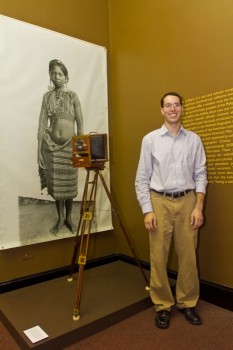Aaron Madow '14 Curates Photo Exhibit in Magill Library

Details
A new photography exhibit opened in Magill Library's Sharpless Gallery in October, but it wasn't curated by a professor, visiting scholar, outside artist or member of the library staff; it was the work of a student. Aaron Madow '14, as the inaugural recipient of the Library Exhibit Internship, is responsible for Seeing Is Believing: Photographs of American Colonialism in the Philippines, a show that explores the American colonization of the Philippines through pictures taken by colonial officials and their accompanying captions.
“The exhibit encourages its viewers to realize the colonial deceit in the assumption that ‘seeing is believing,' ” says Madow.“While the photographer, Charles Martin, and his boss, colonial official Dean Worcester, insisted, through their captions, that one could tell tribal type and level of civilization merely by looking at these photographs, they tellingly clash in their classifications. I argue that their captions reveal the arbitrariness of a supposedly scientific classificatory system, and that they tell us far more about the photographer than the individual in the photograph.”
The exhibit, which will be up in Sharpless Gallery through February 1, is the culmination of work Madow did over the summer that was sponsored by the John B. Hurford '60 Center for the Arts and Humanities and the Library. The internship allowed Madow not only the time and resources to pour over the photographs that were donated to Haverford in 2006 by a Quaker family, but it also funded a nine-day trip to archives at the University of Michigan and Chicago's Newberry Library.
“I am so grateful to the Library and the Humanities Center for giving me this opportunity,” says Madow, a history major and environmental studies minor.“Conducting original archival research is something most Haverford history majors do not get to do until their senior thesis research, and the chance to do it and succeed has taught me so much about what I am capable of and what I want to do with my future.”
Madow first encountered the photographs from the exhibit last fall in Assistant Professor of History Andrew Friedman's class“Gender, Intimacy, & U.S. Foreign Policy,” a course that first sparked Madow's interest in the American empire and its representational strategies. And now that the project is finished, he sees its as good practice for next year's senior thesis, which he plans to write on the cultural history of Israeli-American relations. Additionally, it sparked his interest in committing to further study of imperial history and the use of photography as a historical source.
“When I applied [for the internship], I had a strong analytical background from Professor Friedman's class, but I only knew a week's worth of readings about American colonialism in the Philippines,” he says.“This particular era is so important because it mostly has been effaced from American collective memory, and it heralded America's emergence as a formal colonial power akin to the traditional European ones.”
But Madow learned about more than just the historical moment of the Philippine-American War (1899-1902) and the colonialism that followed. He also learned concrete, high-level research skills and how to design an exhibit, including the collaborative nature of curation.
“I have learned that being the curator of the exhibit is a title which conceals my intimate dependence upon many people,” says Madow.“I received constant support from Terry [Snyder, librarian of the College] and John [Anderies, head of Special Collections], and this exhibit would not have physically come into being without the tireless work of [Library Conservator] Bruce Bumbarger, Thomas Littrell '15 and Whitney Mueller '15…. There are so many people who were also crucial in making this exhibit happened, and their names can all be found at the beginning of the exhibit, prominently displayed right where they belong.”
For Madow's own account of his summer spent researching this project, check the Humanities Center's blog, Decentered.
—Rebecca Raber



